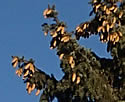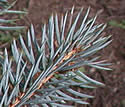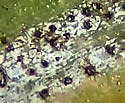Picea pungens (Colorado Spruce)
| Also known as: | Colorado Blue Spruce |
|---|---|
| Genus: | Picea |
| Family: | Pinaceae (Pine) |
| Life cycle: | perennial woody |
| Origin: | central and southern Rockies |
| Habitat: | sun; human landscapes |
| Bloom season: | June |
| Plant height: | 30 to 60 feet |
| Wetland Indicator Status: | GP: FAC MW: none NCNE: FACU |
| MN county distribution (click map to enlarge): |  |
| National distribution (click map to enlarge): |  |
Pick an image for a larger view. See the glossary for icon descriptions.
Detailed Information
Flower:
Male and female flowers are cone like structures called strobili, both borne on the same tree at or near the tips of one year old branches. Males are initially reddish purple becoming yellowish-brown. Females are erect and purple.
Leaves and stems: 

![[photo of needles and branch buds]](/udata/r9ndp23q/pd3/picea-pungens-005-t.jpg) Leaves are needle-like, dark green to light silvery blue, single in a close spiral up the branch, ¾ to 1½ inch long, squarish in cross section, stiff, the tip sharply pointed and very prickly to the touch. The needles typically persist 2 to 3 years in Minnesota.
Leaves are needle-like, dark green to light silvery blue, single in a close spiral up the branch, ¾ to 1½ inch long, squarish in cross section, stiff, the tip sharply pointed and very prickly to the touch. The needles typically persist 2 to 3 years in Minnesota.
![[photo of twig and branch buds]](/udata/r9ndp23q/pd3/picea-pungens-6784326-1-t.jpg) Twigs are orangish to light brown, smooth, turning grayish brown after several seasons with the fallen needles leaving raised roughish leaf scars.
Twigs are orangish to light brown, smooth, turning grayish brown after several seasons with the fallen needles leaving raised roughish leaf scars.
![[photo of trunk]](/udata/r9ndp23q/pd3/picea-pungens-654378-t.jpg) The bark is thin and gray or brownish with flaky scales, older bark can become furrowed. Trunks are typically 12 to 18 inches diameter at breast height (dbh) in Minnesota landscapes.
The bark is thin and gray or brownish with flaky scales, older bark can become furrowed. Trunks are typically 12 to 18 inches diameter at breast height (dbh) in Minnesota landscapes.
Fruit: 
![[photo of cones]](/udata/r9ndp23q/pd3/picea-pungens-89-2-t.jpg) Fruit is an oblong cone, 2 to 4 inches long, straw-colored to light brown, the scales thin and papery with wavy edging and fringed with small, irregular teeth at the tip.
Fruit is an oblong cone, 2 to 4 inches long, straw-colored to light brown, the scales thin and papery with wavy edging and fringed with small, irregular teeth at the tip.
Notes:
Colorado spruce is native to the mountains of the southwestern US and, while heavily planted in both urban and rural landscapes across Minnesota, it has never been documented naturalized. Much of its appeal is due to its distinctive bright blue needles, though seed populations can also range into the dark greens. In spite of its popularity, it is not well adapted to Minnesota's warm, humid summers and mature trees suffer from several disfiguring diseases. Cytospora canker is a bacterial disease that attacks the vascular system, causing dieback of branches and is often accompanied by excessive sap bleeding. Rhizosphaera and Stigmina needlecast are fungi that infect the needles causing premature needle drop that are responsible for the rapid thinning and loss of lower branches. Colorado spruce is readily identifiable by its stiff, very prickly needles and the large cones with a fringed tip on the papery scales.
Native Plant Nurseries, Restoration and Landscaping Services ↓
More photos
 nursery-grown Colorado Spruce trees
nursery-grown Colorado Spruce trees maturing Colorado Spruce trees
maturing Colorado Spruce trees mature Colorado Spruce tree
mature Colorado Spruce tree Colorado Spruce branch
Colorado Spruce branch needle infected with Stigmina lauti
needle infected with Stigmina lauti
Photos courtesy Peter M. Dziuk taken in Anoka and Ramsey counties.
Comments
Have you seen this plant in Minnesota, or have any other comments about it?






